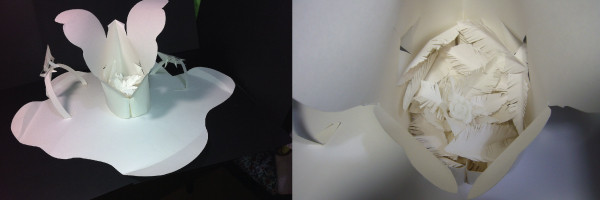Listen 來聽
William is Listening
William在聽
Listen 來聽 / Meanderings - Feature Story 咫尺 - 專題故事 / Feature: On common ground – We are Listening 互補不足 -
Interview/ 採訪: Amber Au/ 急急子
English Translation / 英譯: Winnie Chau/ 周穎榆11/07/2015
ADAHK Jockey Club Inclusive Arts Studio 香港展能藝術會-賽馬會共融藝術工房
audio description, sense of touch, visually impaired, visuals memories, 口述影像, 視覺記憶, 視障, 觸感
When the four of them were discussing what to create, William suggested using paper to make the work, which brought about the following conversation:
(Frances was aided by a sign language interpreter in the meeting.)
Frances:(sign language) Can your work be touched?
William:No, because people may damage it.
Frances:(sign language) If it can’t be touched, then visually impaired people can’t perceive it, can they?
William: They can use audio description.
(William laughs)
Frances:(sign language) Why are you laughing?
William wrote on a piece of paper for Frances, “I laughed because you seem to have become an expert for the visually impaired.”
“I’ve been sensitive to sounds since I was very small. I perceive a lot of things through sounds. When I grew up, I realised others aren’t as sensitive to sounds,” he said. William likes the stars in the sky the most. He also likes the types of sound from wind chimes, music boxes and harps – apart from giving him a taste of fantasy, it gives him the impression of ‘something very beautiful, yet far off.’
Currently a university research assistant, William is fond of ‘moe’. In the past, he enjoyed watching anime Lucky Star and Puella Magi Madoka Magica. Sometimes, he would be moved to tears when he was watching anime. Before entering university, his eyesight could still manage.
At kindergarten, William was diagnosed with macular (yellow spot) degeneration. There was no remedy for this condition. As a small child, he would still play hide-and-seek and football with other children. “I used to be able to use a magnifier to read books. A significant degeneration appeared when I was around Form 6 and Form 7. It felt like a patch of thing blocking the middle of my eyes.” Now, he has less than 10% eyesight. More specifically, he can’t make out the biggest ‘E’ on the eye chart. As he has been visually impaired since he was small, he would use hearing as an aid. This is how he describes sound: “Many things in daily life rely on sound. I even chain-read novels by listening. Sound is a part of life. [We are] always together.”
Being able to see previously, William feels deeply the difference between ‘seeing’ and ‘listening’: “listening can complement a bit, but at the end of the day many things can’t be understood by listening to their sound.” The first example is travelling. He isn’t that interested in travelling, as many sightseeing spots require our eyes to see. Merely listening to audio description feels very detached. He jokes, “But I’m interested in eating the food in different countries.” The second example is ‘watching film’ via audio description. He finds audio description similar to audiobook. Yet, the description in an audiobook is more detailed than ‘listening to film’, which enables him to imagine the scenarios.
He can feel the inevitable disappointment when words are used to describe images. “When an anime is described verbally, some gags would be omitted. Many things are to be appreciated visually. If they turned into something audio, they couldn’t be heard completely or perceived at all.”
Visual/ Non-visual
In his teens, William liked drawing, “If I could still draw, I’d still be fond of drawing.” After his eyesight became too deteriorated for him to draw, he hoped to use other media to create. Yet, he realised ordinary art studios didn’t offer art courses suitable for the visually impaired until he discovered Arts with the Disabled Association Hong Kong (ADA). At ADA, he took part in drama, paper art and touch art workshops. Since he was previously able to see, his works are a bit unusual. Take paper art creations, though he couldn’t see how the work looked in the creative process, he somehow created by means of the visuals in his memories, rather than solely depending on the sense of touch. As for the final product, he hoped the audience, too, would perceive it visually, but not through their sense of touch.
He felt that he couldn’t completely handle visual-related creative media. Later, he came across ‘Itchy Ears’ at ADA, “at first I didn’t know what sound art was, but I thought I could handle this medium.” He described, before joining ‘Itchy Ears’, he was relatively passive when he listened. Neither would he think about the connection between sounds, nor imagine how to create sounds. After joining ‘Itchy Ears’, he started to record different sounds to create his own sound library. He then made use of the recorded sounds to create, “for the time being, I’m exploring. It’s certainly very interesting.”
At one of the learning group meetings, William submitted a segment of sounds made by mixing software. It’s about a day of his daily life. It’s composed of different types of sounds, which are rhythmic with various added effects. The software he used was the same as that used by the visually able. It’s just that the visually able would use it more smoothly… actually it isn’t always the case.
He has a plan, which is to use sounds to narrate ‘The Story of Turtle and Rabbit Race’.
(please scroll down for William’s creation)
四位在討論想一起做什麼創作的時候,William提出,他可以用紙張砌一件作品,引發以下對話:
(Frances在㑹議時㑹有手語翻譯員輔助。)
Frances:(手語翻譯)你件作品可唔可以摸?
William:唔可以摸,因為可能㑹畀人整爛。
Frances:(手語翻譯)如果唔可以摸,咁視障人士咪感受唔到?
William:可以用口述影像。
William笑。
Frances:(手語翻譯)你做乜笑?
William在紙上寫給Frances:「我笑,係笑你點解好似變咗視障專家。」
「我好細個已經對聲音敏感,好多嘢都係用聲音去感受。後尾大個咗先發現,原來其他人對聲音無咁敏感。」William最喜歡天上的星星,也很喜歡像風鈴、音樂盒或是樹琴那般的聲音,除了給他有一種夢幻的感覺外,那還給他一種「很美麗但很遙遠」的感覺。
現於大學當研究助理的William喜歡「萌」,以前他喜歡看動畫《Lucky Star》、《魔法少女小圓》,看動畫的時候,有時㑹感動落淚。在讀大學之前,眼睛還應付得來。
在上幼稚園的時候,William被診斷眼睛的中央黃斑點出現退化,這種狀況,沒有治療方法。小時候,他還㑹跟其他小朋友玩捉迷藏、踢波:「以前可以用放大鏡睇書。好明顯嘅退化就喺中六、七出現,感覺眼睛中央有撻嘢遮住咗。」現在,他餘下不到一成的視力,具體一點,就是驗眼的時候,連最大的E字也看不到。由於自小已有視障,他㑹用聽覺來輔助。他這樣形容聲音:「生活好多嘢都係靠聲音,煲小説都係靠聽。聲音係生活一部份,成日都一齊。」
曾經看得到,所以William很感受到「睇」和「聽」的分別:「用聽覺可以補足少少,但始終好多嘢,聽聲都唔知係咩嘢。」第一個例子,是去旅行。他對去旅行的興趣不大,因為許多景點都要靠雙眼去看,只聽聲音描述,感覺很抽離,他笑説:「但我對去唔同國家食嘢有興趣。」第二個例子,是用口述影像「睇戲」。他覺得口述影像就像audiobook(錄音書),但錄音書對事物的描述,㑹比「聽戲」更細緻,讓他更能想像當中的畫面。
他很感受到,用語言來形容影像,總有點失落:「如果口述一套動畫,有啲gag位㑹無咗。有好多嘢係視覺嘅欣賞,如果變成聽覺,係會聽唔晒或者感受唔到。」
視覺/不視覺
少年時代,William喜歡畫畫:「如果畫到畫,我都係鍾意畫畫。」在視力不能再支撐他畫畫後,他希望可以嘗試其他創作媒介,但他發現,普通的美術教室,並沒有適合視障人士的藝術課,直至他發現展能藝術會(ADA)。他在ADA參加過劇場、紙藝、觸感藝術等工作坊。由於他曾看得見,讓他的作品有點特殊。以紙藝創作為例,雖然在創作過程中,他看不到作品的模樣,但其實在某程度上,他是以視覺記憶去做創作,並不單單靠觸感去創作。而最終的作品,他亦希望觀眾是用視覺去感受,並非用觸感去感受。
涉及視覺的創作媒介,他感到未能完全掌握,後來,他在ADA接觸到「抓耳朵」:「初初唔知咩嘢係聲音藝術,但覺得自己可以掌握到呢個媒介。」他形容在「抓耳朵」之前,他聆聽聲音時較為被動,亦不㑹去思考聲音之間的連繫,不㑹想像可以如何創作聲音。「抓耳朵」後,他開始把不同的聲音錄下,製作一個自己的sound library,再用儲下來的聲音做創作:「暫時都係探索緊,當然係好得意。」
在一次學習小組㑹議中,William交了一段用混音軟件製作的聲音,內容關於他一天的生活,由多種聲音組成,富節奏感,又運用了不同效果。他用的軟件,跟健視人士用的一樣,只是健視人士㑹用得順暢一點……其實也不一定。
他有個計劃,想用聲音來説龜兔賽跑的故事。
:: William’s creation in sound ::
:: William的聲音創作 ::
A Day of My Life 我的一天
—
Previous paper artwork 過往紙藝作品
